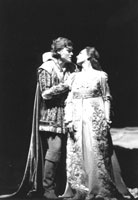|

Is
The Cultural Pendulum Swinging West To Chicago?
Visual
delights at the Art Institute and heavenly singing at the Lyric
Opera
By
Irving Spitz
Art
lovers have always held Van Gogh and Gauguin in fascination, and
over the last two decades there have been numerous exhibitions
devoted to these two masters. The Metropolitan mounted Van
Gogh in Arles in 1984 and two years later Van Gogh in Saint-Remy
and Auvers. There was the huge Van Gogh retrospective in Amsterdam
in 1990, the centennial of his death. Gauguin had his turn in
1988 at The National Gallery in Washington and the Art Institute
of Chicago. These shows were encyclopedic in scope and content.
All were good, some were outstanding, but the current exhibit
at The Arts Institute of Chicago, Van Gogh and Gauguin: The
studio of the South has outdone them all. The curators of
this landmark show took a different approach and analyzed the
complex personal and artistic relationships between these two
giants, who lived together in Arles for nine weeks in 1888. Indeed,
this is the first show to explore this interesting theme. It was
Van Gogh who conceived the idea of establishing a studio of the
South and invited Gauguin to join him, although this proposal
never came to fruition. Severe differences in temperament and
working habits led to an inevitable split, which culminated in
the well-known episode whereby Van Gogh cut off part of his ear.
Gauguin left Christmas Day, 1888 and the two artists were never
to meet again.
This show demonstrates the scholarship, intelligence and perseverance
of its curators. It was reported to have taken over 11 years in
preparation. Particularly interesting are the varied work techniques
of the two artists. Gauguin painted slowly and meticulously. Van
Gogh, in contrast, painted rapidly, even ferociously, immediately
applying oil to canvas. These differences in style are dramatically
evident in their series pained at the Alyscamps, a lane of old
Roman tombs where they set up their easels side by side. The curators
even recreated the studio where the two artists worked. All this
is brilliantly chronicled by curators Douglas W Druick and Peter
Kort Zegers in their 418-page catalog. Van Gogh was probably the
most prolific artist of all time. His total creative art span
was less than 10 years, but his output comprised over 1500 paintings
and drawings. Of the two artists, Van Gogh had the most profound
influence on future artists. Eleven years after Van Gogh’s death,
Gauguin painted a series of sunflowers in his tribute. This outstanding
show is co-curated by the Van Gogh Museum in Amsterdam and will
also travel to Amsterdam, its final stop. Lucky are those privileged
to attend such a visual and intellectual extravaganza.
As every opera buff is aware, 2001 was the centenary of the death
of Verdi. Not so many know that this was also the 200th anniversary
of the birth of Vincenzo Bellini, the Sicilian composer who died
at age 34 and composed nine operas. In honor of this, there were
new productions of La Sonambulla in Vienna and Norma
at The Metropolitan. The New York City Opera put on its first
production of Capuleti e i Montecchi I (the Capulets
and the Montagues) while the Chicago Lyric mounted a revival of
their 1985 production of this opera. Without question, the Lyric
production was the pick of the bunch.
Bellini’s librettist was Felice Romani, one of the foremost Italian
poets of the day. Romani adapted the Romeo and Juliet story for
his opera; indeed, he had already done this previously for an
opera on the same theme by the composer Nicola Vaccai, an older
contemporary of Bellini. Romani’s text has only a remote resemblance
to Shakespeare’s play. Romeo is sung by a mezzo and to carry this
off convincingly, a mezzo of real stature is required. The Lyric
was fortunate to have an artist available to deliver the goods,
the Bulgarian Vessilina Kasarova. Her Juliet was Hungarian soprano
Andrea Rost. Whether alone or in their passionate duets, these
two consummate artists pulled off a real coup and complemented
each other beautifully. Both sung with flawless musicianship.
Kasarova has a wonderful low register that few other mezzos around
can match, and she demonstrated an extraordinary control of dynamics.
Post’s silvery soprano was the stuff of dreams. There was a strong
supporting cast with Italian tenor Fabio Santori as Tebaldo. Capellio,
Giulietta’s dominant father and Lorenzo the priest were competently
sung by basses Jeffrey Wells and Umberto Chiummo. But this was
a woman’s night. Conductor Bruno Campanella, in his Lyric debut,
managed to coax the beautiful bel canto lines from the orchestra.
The sets, designed by Ulisse Santicchi, consisted of shining black
marble walls, staircases and floors. I Capuleti e i Montecchi
did honor to both Bellini and Chicago.
I only spent one day in Chicago, but the visit to the Art Institute
followed by the performance at the Lyric Opera, left me with the
impression that Chicago is a serious challenger to New York for
US cultural supremacy.#
Education Update, Inc., P.O. Box 20005, New York, NY 10001. Tel:
(212) 481-5519. Fax: (212) 481-3919. Email: ednews1@aol.com.
All material is copyrighted and may not be printed without express consent of
the publisher. © 2001.
|

